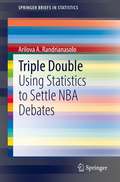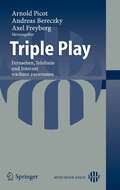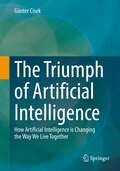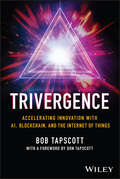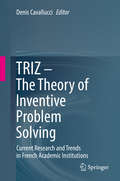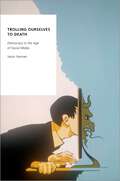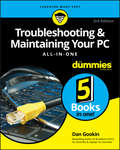- Table View
- List View
A Tribute to Prof. Dr. Da Ruan
by Jie Lu Etienne KerreThis volume is a tribute to Professor Dr Da Ruan, who passed away suddenly on July 31, 2011, aged 50. The flood of emails that spread throughout the fuzzy logic research community with the tragic news was testimony to the respect and liking felt for this remarkable man. Da was a hardworking , highly productive scientist who, during his short life, published 35 books and more than 250 research papers in highly ranked journals and conference proceedings. He established two successful conferences, FLINS and ISKE, as well as the international journal, JCIS. This book is a collection of contributions from 88 of Da's academic friends from 47 institutes, presented in 60 chapters and over 70 pictures. A Foreword by Lotfi Zadeh begins Da's story. Section 1 provides an overview of Da's funeral on August 6, 2011. Part II outlines Da’s scientific life, his education, scientific career, publications and keynote talks. Part III presents testimonials by Da's colleagues of academic activities, including guest professorships and his many visits to foreign institutes. Part IV contains thirty contributions from colleagues and friends across the world to describe their collaborative experience with Da. We hope this book will keep the memory of Da alive – great scientist, great friend, great humanitarian. He will remain in our hearts forever.
Triggermechanismen in Datenbanksystemen (Informatik-Fachberichte #201)
by Angelika M. KotzDatenbanksysteme müssen - speziell in Nicht-Standard-Anwendungen wie CAD/CAM u.ä. - neben den rein passiven Datenbeständen auch aktive Elemente verwalten. Dies gilt in besonderem Maße im Bereich der Konsistenzsicherung von Mengen hochkomplexer Daten und Regeln, in dem bisher entwickelte Lösungen nicht ausreichen. Das Buch stellt dar, wie Triggermechanismen den entsprechenden Anforderungen gerecht werden können. Es wird ein umfassendes und allgemein einsetzbares Konzept - der Event-Trigger-Mechanismus ETM - neu entwickelt und in seinen Eigenschaften detailliert dargestellt. Der ETM gliedert sich als eigenständige Komponente in die DBMS-Architektur ein. Darauf aufbauend werden Systemschichten für die Definition von Dämonen zur Zustandsüberwachung und für die Realisierung von Konsistenzregeln eingesetzt. Ausführliche Beispiele und Angaben zur Implementierung runden die Darstellung der Konzeption ab. Der Mechanismus ist neben der Konsistenzsicherung für eine Reihe weiterer Aufgaben wie Reorganisation, Alarmbehandlung, Zugriffsüberwachung usw. einsetzbar.
Trillions: How a Band of Wall Street Renegades Invented the Index Fund and Changed Finance Forever
by Robin Wigglesworth'Grab some popcorn and take a front row seat, because Robin Wigglesworth has an astonishing story to tell you'Tim Harford, author of How to Make the World Add Up'A terrific read'Gregory Zuckerman, author of The Man Who Solved the Market'A fascinating journey and a crucial book'Bradley Hope, author of Billion Dollar WhaleFifty years ago, an unlikely group quietly assembled in the financial industry's backwaters, unified by the heretical idea that even the world's best investors couldn't beat the market in the long run. Including economist wunderkind Gene Fama, industry executive Jack Bogle, computer-obsessive John McQuown and former Second World War submariner Nate Most, the group succeeded beyond their wildest dreams.Passive investing now likely accounts for over $26 trillion, equal to the entire gross domestic product of the US, and today is a force reshaping markets, finance and even capitalism itself.Yet even some fans of index funds and ETFs are growing perturbed that their swelling heft is destabilizing markets, wrecking the investment industry and leading to an unwelcome concentration of power in fewer and fewer hands.In Trillions, Financial Times journalist Robin Wigglesworth unveils the vivid secret history of index funds, bringing to life the colourful characters behind their birth, growth and evolution into a world-conquering phenomenon. It is the untold story behind one of the most pressing financial uncertainties of our time.'An easy-to-understand and fun read, full of lively characters and little-known details of how finance really works today' Gillian Tett, US editor-at-large at the Financial Times and author of Anthro-Vision
Triple Double: Using Statistics to Settle NBA Debates (SpringerBriefs in Statistics)
by Arilova A. RandrianasoloThis book provides empirical evidence and statistical analyses to uncover answers to some of the most debated questions in the NBA. The sports world lives and breathes off of debates on who deserves an MVP award, and which athletes should be considered all-stars. This book provides some statistics-backed perspectives to some of these debates that are specific to the NBA. Was LeBron snubbed of an MVP in the 2010-2011 season? Why has the G.O.A.T. debate turned into LeBron vs. Jordan….Did Kobe get overlooked? How come Klay Thompson didn’t get All-NBA honors in the 2018-2019 season? This book explores these questions and many more with empirical evidence. This book is invaluable for any undergraduate or masters level course in sport analytics, sports marketing, or sports management. It will also be incredibly useful for scouts, recruiters, and general managers in the NBA who would like to use analytics in their work.
Triple Play: Fernsehen, Telefonie und Internet wachsen zusammen
by Andreas Bereczky Axel FreybergDie Kommunikations- und Medienlandschaft steht vor einem Umbruch. Bisher getrennt angebotene Individual- und Massenmedien (Telefonie, Internet, TV) können nun über dieselben Endgeräte und Infrastrukturen gebündelt angeboten und vermarktet werden. Die ersten kommerziellen Triple-Play-Angebote befinden sich in Vorbereitung oder Markteinführung. Der MÜNCHNER KREIS präsentiert hier Trends, Voraussetzungen, Perspektiven und Rahmenbedingungen.
Tripping Points on the Roads to Outwit Terror (Advanced Sciences and Technologies for Security Applications)
by Yair Sharan Ted J. Gordon Elizabeth FlorescuThis book assesses potential developments of terrorism and ways to prevent it—the growing threats as new technologies become available — and how the same new technologies may help trap those with potential mal-intent. The drumbeat of terror resonates from everywhere; how can we stop it? What are the tripping points along the road and how can we avoid them? Increasingly more people have access to increasingly more information and increasingly more destructive technologies. In the meantime, increasingly advanced technologies help us create an increasingly safer and more harmonious world. Advantages and disadvantages are accelerating each other. While hybrid threats are intensifying, so are the opportunities to address them. But what are the compromises and how can we mitigate them? This book also looks at the unexpected and often random success and failure of policies to counter the evolving terror threat. The various aspects of the terrorism phenomena are presented in a unique way using scenario vignettes, which give the reader a realistic perception of the threat. The combination of positive and negative implications of emerging technologies is describing what might well be one of the most important dimensions of our common future.
The Triumph of Artificial Intelligence: How Artificial Intelligence is Changing the Way We Live Together
by Günter CisekThe book demonstrates to readers interested in social life in an understandable way how AI works and how it will dramatically change all areas of life. From the history of AI to its techniques and its diverse fields of application to its ethical-philosophical implications, all relevant aspects are presented in detail. The author does not remain descriptive, but also takes a critical stance on AI development in clear words. For the reader, the explanations are designed as a professional support corset, in order to be able to act as a knowledgeable counterpart to the AI experts. The last two chapters take the reader into the future of life with super AI. With daring scenarios, the author alerts the reader in an enjoyable way to the breathtaking and socially highly explosive perspectives associated with AI and the ethical and philosophical questions that arise from it.This book is a translation of the original German 1st edition Machtwechsel der Intelligenzen by Günter Cisek, published by Springer Fachmedien Wiesbaden GmbH, part of Springer Nature in 2021. The translation was done with the help of artificial intelligence (machine translation by the service DeepL.com). A subsequent human revision was done primarily in terms of content, so that the book will read stylistically differently from a conventional translation. Springer Nature works continuously to further the development of tools for the production of books and on the related technologies to support the authors.
TRIVERGENCE: Accelerating Innovation with AI, Blockchain, and the Internet of Things
by Bob TapscottA Breakthrough Introduction to The Next Phase of the Digital Age In Trivergence, Bob Tapscott, writer, speaker, complex system designer, and former CIO introduces an exciting new concept in explaining how the intersection of artificial intelligence (AI), blockchain, and the Internet of Things (IoT) will transform business and society. He explains the synergies between these technologies and the disruptive potential that they will offer, as well as the challenges and risks to making it happen. He offers an insightful guide through the difficult decisions that businesses and society must make to thrive in a new era where decisions will be difficult, and uncertainties abound. You'll discover how and why AI's power is now exploding, its growth driven by smarter approaches to neural networks trained on a new hardware architecture that can derive its intelligence from ever more massive datasets. You'll also find: Discussions of the multiplicative and exponential power of trivergence on the core technologies discussed in the book Explorations of IoT's tendency to bring the physical world to life as it harnesses the capabilities of AI and the blockchain How trivergence morphs Big Data into something new he calls “Infinite Data”, where thinking machines consider trillions of data points to generate their own content, value, and perspectives without programmed code or human intervention A fresh and innovative guide, rich with case stories, on how the most critical technologies of this new phase in the digital age are combining to drive business transformation, Trivergence will become a critical handbook for forward-looking leaders, and anyone interested in the intersection of cutting-edge tech and business.
TRIVERGENCE: Accelerating Innovation with AI, Blockchain, and the Internet of Things
by Bob TapscottA Breakthrough Introduction to The Next Phase of the Digital Age In Trivergence, Bob Tapscott, writer, speaker, complex system designer, and former CIO introduces an exciting new concept in explaining how the intersection of artificial intelligence (AI), blockchain, and the Internet of Things (IoT) will transform business and society. He explains the synergies between these technologies and the disruptive potential that they will offer, as well as the challenges and risks to making it happen. He offers an insightful guide through the difficult decisions that businesses and society must make to thrive in a new era where decisions will be difficult, and uncertainties abound. You'll discover how and why AI's power is now exploding, its growth driven by smarter approaches to neural networks trained on a new hardware architecture that can derive its intelligence from ever more massive datasets. You'll also find: Discussions of the multiplicative and exponential power of trivergence on the core technologies discussed in the book Explorations of IoT's tendency to bring the physical world to life as it harnesses the capabilities of AI and the blockchain How trivergence morphs Big Data into something new he calls “Infinite Data”, where thinking machines consider trillions of data points to generate their own content, value, and perspectives without programmed code or human intervention A fresh and innovative guide, rich with case stories, on how the most critical technologies of this new phase in the digital age are combining to drive business transformation, Trivergence will become a critical handbook for forward-looking leaders, and anyone interested in the intersection of cutting-edge tech and business.
TRIZ – The Theory of Inventive Problem Solving: Current Research and Trends in French Academic Institutions
by Denis CavallucciThe work presented here is generally intended for engineers, educators at all levels, industrialists, managers, researchers and political representatives. Offering a snapshot of various types of research conducted within the field of TRIZ in France, it represents a unique resource.It has been two decades since the TRIZ theory originating in Russia spread across the world. Every continent adopted it in a different manner – sometimes by glorifying its potential and its perspectives (the American way); sometimes by viewing it with mistrust and suspicion (the European way); and sometimes by adopting it as-is, without questioning it further (the Asian way). However, none of these models of adoption truly succeeded.Today, an assessment of TRIZ practices in education, industry and research is necessary. TRIZ has expanded to many different scientific disciplines and has allowed young researchers to reexamine the state of research in their field. To this end, a call was sent out to all known francophone research laboratories producing regular research about TRIZ. Eleven of them agreed to send one or more of their postdoctoral researchers to present their work during a seminar, regardless of the maturity or completeness of their efforts. It was followed by this book project, presenting one chapter for every current thesis in order to reveal the breadth, the richness and the perspectives that research about the TRIZ theory could offer our society. The topics dealt with e.g. the development of new methods inspired by TRIZ, educational practices, and measuring team impact.
Trojans, Worms, and Spyware: A Computer Security Professional's Guide to Malicious Code
by Michael ErbschloeTrojans, Worms, and Spyware provides practical, easy to understand, and readily usable advice to help organizations to improve their security and reduce the possible risks of malicious code attacks. Despite the global downturn, information systems security remains one of the more in-demand professions in the world today. With the widespread use of the Internet as a business tool, more emphasis is being placed on information security than ever before. To successfully deal with this increase in dependence and the ever growing threat of virus and worm attacks, Information security and information assurance (IA) professionals need a jargon-free book that addresses the practical aspects of meeting new security requirements. This book provides a comprehensive list of threats, an explanation of what they are and how they wreak havoc with systems, as well as a set of rules-to-live-by along with a system to develop procedures and implement security training. It is a daunting task to combat the new generation of computer security threats – new and advanced variants of Trojans, as well as spyware (both hardware and software) and “bombs" – and Trojans, Worms, and Spyware will be a handy must-have reference for the computer security professional to battle and prevent financial and operational harm from system attacks.*Provides step-by-step instructions to follow in the event of an attack *Case studies illustrate the "do's," "don'ts," and lessons learned from infamous attacks *Illustrates to managers and their staffs the importance of having protocols and a response plan in place
Trolling Ourselves to Death: Democracy in the Age of Social Media (Oxford Studies in Digital Politics)
by Jason HannanAlmost forty years ago, Neil Postman argued that television had brought about a fundamental transformation to democracy. By turning entertainment into our supreme ideology, television had recreated public discourse in its image and converted democracy into show business. In Trolling Ourselves to Death, Jason Hannan builds on Postman's classic thesis, arguing that we are now not so much amusing, as trolling ourselves to death. Yet, how do we explain this profound change? What are the primary drivers behind the deterioration of civic culture and the toxification of public discourse? Trolling Ourselves to Death moves beyond the familiar picture of trolling by recasting it in a broader historical light. Contrary to the popular view of the troll as an exclusively anonymous online prankster who hides behind a clever avatar and screen name, Hannan asserts that trolls have emerged from the cave, so to speak, and now walk in the clear light of day. Trolls now include politicians, performers, patriots, and protesters. What was once a mysterious phenomenon limited to the darker corners of the Internet has since gone mainstream, eroding our public culture and changing the rules of democratic politics. Hannan shows how trolling is the logical outcome of a culture of possessive individualism, widespread alienation, mass distrust, and rampant paranoia. Synthesizing media ecology with historical materialism, he explores the disturbing rise of political unreason in the form of mass trolling and sheds light on the proliferation of disinformation, conspiracy theory, "cancel culture," and digital violence. Taking inspiration from Robert Brandom's innovative reading of Georg Wilhelm Friedrich Hegel, Trolling Ourselves to Death makes a case for building "a spirit of trust" to curb the epidemic of mass distrust that feeds the plague of political trolling.
Trolling Ourselves to Death: Democracy in the Age of Social Media (Oxford Studies in Digital Politics)
by Jason HannanAlmost forty years ago, Neil Postman argued that television had brought about a fundamental transformation to democracy. By turning entertainment into our supreme ideology, television had recreated public discourse in its image and converted democracy into show business. In Trolling Ourselves to Death, Jason Hannan builds on Postman's classic thesis, arguing that we are now not so much amusing, as trolling ourselves to death. Yet, how do we explain this profound change? What are the primary drivers behind the deterioration of civic culture and the toxification of public discourse? Trolling Ourselves to Death moves beyond the familiar picture of trolling by recasting it in a broader historical light. Contrary to the popular view of the troll as an exclusively anonymous online prankster who hides behind a clever avatar and screen name, Hannan asserts that trolls have emerged from the cave, so to speak, and now walk in the clear light of day. Trolls now include politicians, performers, patriots, and protesters. What was once a mysterious phenomenon limited to the darker corners of the Internet has since gone mainstream, eroding our public culture and changing the rules of democratic politics. Hannan shows how trolling is the logical outcome of a culture of possessive individualism, widespread alienation, mass distrust, and rampant paranoia. Synthesizing media ecology with historical materialism, he explores the disturbing rise of political unreason in the form of mass trolling and sheds light on the proliferation of disinformation, conspiracy theory, "cancel culture," and digital violence. Taking inspiration from Robert Brandom's innovative reading of Georg Wilhelm Friedrich Hegel, Trolling Ourselves to Death makes a case for building "a spirit of trust" to curb the epidemic of mass distrust that feeds the plague of political trolling.
TRON Project 1987 Open-Architecture Computer Systems: Proceedings of the Third TRON Project Symposium
by Ken SakamuraAlmost 4 years have elapsed since Dr. Ken Sakamura of The University of Tokyo first proposed the TRON (the realtime operating system nucleus) concept and 18 months since the foundation of the TRON Association on 16 June 1986. Members of the Association from Japan and overseas currently exceed 80 corporations. The TRON concept, as advocated by Dr. Ken Sakamura, is concerned with the problem of interaction between man and the computer (the man-machine inter face), which had not previously been given a great deal of attention. Dr. Sakamura has gone back to basics to create a new and complete cultural environment relative to computers and envisage a role for computers which will truly benefit mankind. This concept has indeed caused a stir in the computer field. The scope of the research work involved was initially regarded as being so extensive and diverse that the completion of activities was scheduled for the 1990s. However, I am happy to note that the enthusiasm expressed by individuals and organizations both within and outside Japan has permitted acceleration of the research and development activities. It is to be hoped that the presentations of the Third TRON Project Symposium will further the progress toward the creation of a computer environment that will be compatible with the aspirations of mankind.
TRON Project 1988: Open-Architecture Computer Systems
by Ken SakamuraIt has been almost 5 years since the inauguration of the TRON project, a concept first proposed by Dr. K. Sakamura of the University of Tokyo. The TRON Association, which was founded as an independent organization in March 1988, has been taking over the activities of the earlier TRON Association, which was a division of Japan Electronic Industry Development Association (JEIDA). It has been expanding various operations to globalize the organizations activities. The number of member companies already exceeds 100, with increasing participation from overseas companies. It is truly an awaring historical event that so many members with the same qualifications and aims engaged in the research and development of the computer environment could be gathered together. The TRON concept aims at the creation of a new and complete environment beneficial to both computer and mankind. It has a very wide scope and great diversity. As it includes the open architecture concept and as the TRON machine should be able to work with various foreign languages, the TRON is targetted to be used internationally. In order for us to create a complete TRON world, at though there are several TRON products already on the market, continuous and aggressive participation from as members together with concentration as further development are indispensable. We, the TRON promoters, are much encouraged by such a driving force.
TRON Project 1989: Open-Architecture Computer Systems
by Ken SakamuraIt is almost six years since the inauguration of the TRON project, a con cept first proposed by Dr. K. Sakamura of the University of Tokyo, and it is almost 2 years since the foundation of the TRON Association on March 1988. The number of regular member companies registered in the TRON Association as of November 1988 is 145 which is a new re cord for the Association. Some of this year's major activities that I would particularly like to mention are: - Over 50 TRON project-related products have been or are about to be introduced to the marketplace, according to a preliminary report from the Future Study Committee of the TRON Association. In par ticular, I am happy to say that the ITRON subproject, which is ahead of the other subprojects, has progressed so far that several papers on ITRON applications will be presented at this conference, which means that the ITRON specifications are now ready for application to em bedded commercial and industrial products.
TRON Project 1990: Open-Architecture Computer Systems
by Ken SakamuraI wish to extend my warm greetings to you all on behalf of the TRON Association, on this occasion of the Seventh International TRON Project Symposium. The TRON Project was proposed by Dr. Ken Sakamura of the University of Tokyo, with the aim of designing a new, comprehen sive computer architecture that is open to worldwide use. Already more than six years have passed since the project was put in motion. The TRON Association is now made up of over 140 co m panies and organizations, including 25 overseas firms or their affiliates. A basic goal of TRON Project activities is to offer the world a human-oriented computer culture, that will lead to a richer and more fulfilling life for people throughout the world. It is our desire to bring to reality a new order in the world of computers, based on design concepts that consider the needs of human beings first of all, and to enable people to enjoy the full benefits of these com puters in their daily life. Thanks to the efforts of Association members, in recent months a number of TRON-specification 32-bit microprocessors have been made available. ITRON-specification products are continuing to appear, and we are now seeing commercial implementations of BTRON specifications as well. The CTRON subproject, mean while, is promoting standardization through validation testing and a portability experiment, and products are being marketed by sev eral firms. This is truly a year in which the TRON Project has reached the practical implementation stage.
Tropical Circuit Complexity: Limits of Pure Dynamic Programming (SpringerBriefs in Mathematics)
by Stasys JuknaThis book presents an enticing introduction to tropical circuits and their use as a rigorous mathematical model for dynamic programming (DP), which is one of the most fundamental algorithmic paradigms for solving combinatorial, discrete optimization problems. In DP, an optimization problem is broken up into smaller subproblems that are solved recursively. Many classical DP algorithms are pure in that they only use the basic (min,+) or (max,+) operations in their recursion equations. In tropical circuits, these operations are used as gates. Thanks to the rigorous combinatorial nature of tropical circuits, elements from the Boolean and arithmetic circuit complexity can be used to obtain lower bounds for tropical circuits, which play a crucial role in understanding the limitations and capabilities of these computational models. This book aims to offer a toolbox for proving lower bounds on the size of tropical circuits.In this work, the reader will find lower-bound ideas and methods that have emerged in the last few years, with detailed proofs. Largely self-contained, this book is meant to be approachable by graduate students in mathematics and computer science with a special interest in circuit complexity.
The Trouble With Sharing: Interpersonal Challenges in Peer-to-Peer Exchange (Synthesis Lectures on Human-Centered Informatics)
by Airi LampinenPeer-to-peer exchange is a type of sharing that involves the transfer of valued resources, such as goods and services, among members of a local community and/or between parties who have not met before the exchange encounter. It involves online systems that allow strangers to exchange in ways that were previously confined to the realm of kinship and friendship. Through the examples in this book, we encounter attempts to foster the sharing of goods and services in local communities and consider the intricacies of sharing homes temporarily with strangers (also referred to as hospitality exchange or network hospitality). Some of the exchange arrangements discussed involve money while others explicitly ban participants from using it. All rely on digital technologies, but the trickiest challenges have more to do with social interaction than technical features. This book explores what makes peer-to-peer exchange challenging, with an emphasis on reciprocity, closeness, and participation: How should we reciprocate? How might we manage interactions with those we encounter to attain some closeness but not too much? What keeps people from getting involved or draws them into exchange activities that they would rather avoid? This book adds to the growing body of research on exchange platforms and the sharing economy. It provides empirical examples and conceptual grounding for thinking about interpersonal challenges in peer-to-peer exchange and the efforts that are required for exchange arrangements to flourish. It offers inspiration for how we might think and design differently to better understand and support the efforts of those involved in peer-to-peer exchange. While the issues cannot be simply “solved” by technology, it matters which digital tools an exchange arrangement relies on, and even seemingly small design decisions can have a significant impact on what it is like to participate in exchange processes. The technologies that support exchange arrangements—often platforms of some sort—can be driven by differing sets of values and commitments. This book invites students and scholars in the Human–Computer Interaction community, and beyond, to envision and design alternative exchange arrangements and future economies.
Troubleshoot PC Problems Yourself: Troubleshoot Pc Problems Yourself (Flash)
by Anthony PriceThe books in this bite-sized new series contain no complicated techniques or tricky materials, making them ideal for the busy, the time-pressured or the merely curious. Based on Windows 7 Troubleshoot PC Problems Yourself is a short, simple and to-the-point guide to carrying out the bulk of maintenance and upgrade tasks for the Windows 7 operating system using little more than a single screwdriver and standard software tools. In just 96 pages, the reader will discover how to deal with most tasks without the costly help of an IT consultant.
Troubleshooting and Maintaining Your PC All-in-One Desk Reference For Dummies: All-in-one Desk Reference For Dummies
by Dan GookinMaintaining a PC is important, and troubleshooting a PC can be a challenge. Dan Gookin is great at explaining how to handle common PC problems, and he’s provided a complete, plain-English manual in Troubleshooting & Maintaining Your PC All-in-One For Dummies. Liberally laced with Dan’s famous humor and clear instructions, Troubleshooting & Maintaining Your PC All-in-One For Dummies is divided into six minibooks covering hardware, software, laptops, Internet, networking, and maintenance. Each one gives you some background on what causes common problems, to help you understand what’s wrong as well as how to fix it. You’ll learn to: Troubleshoot both Windows XP and Vista Solve e-mail and Web woes, makes friends with ActiveX, and protect your system from evil software and viruses Resolve router problems, reset the modem, delve into IP addresses, and find the elusive wireless network Investigate startup issues, battery quirks, and power problems Travel safely and efficiently with your laptop Perform regular maintenance and keep good backups Solve problems with disks and printers Find missing files, successfully restore files if something major goes wrong, and pep up your PC The bonus DVD walks you through some of the complex steps discussed in the book and demonstrates tasks like removing a hard drive. There’s a great collection of free and demo software, too. Troubleshooting & Maintaining Your PC All-in-One For Dummies is tech support in a book! Note: CD-ROM/DVD and other supplementary materials are not included as part of eBook file.
Troubleshooting and Maintaining Your PC All-in-One Desk Reference For Dummies
by Dan GookinMaintaining a PC is important, and troubleshooting a PC can be a challenge. Dan Gookin is great at explaining how to handle common PC problems, and he’s provided a complete, plain-English manual in Troubleshooting & Maintaining Your PC All-in-One For Dummies. Liberally laced with Dan’s famous humor and clear instructions, Troubleshooting & Maintaining Your PC All-in-One For Dummies is divided into six minibooks covering hardware, software, laptops, Internet, networking, and maintenance. Each one gives you some background on what causes common problems, to help you understand what’s wrong as well as how to fix it. You’ll learn to: Troubleshoot both Windows XP and Vista Solve e-mail and Web woes, makes friends with ActiveX, and protect your system from evil software and viruses Resolve router problems, reset the modem, delve into IP addresses, and find the elusive wireless network Investigate startup issues, battery quirks, and power problems Travel safely and efficiently with your laptop Perform regular maintenance and keep good backups Solve problems with disks and printers Find missing files, successfully restore files if something major goes wrong, and pep up your PC The bonus DVD walks you through some of the complex steps discussed in the book and demonstrates tasks like removing a hard drive. There’s a great collection of free and demo software, too. Troubleshooting & Maintaining Your PC All-in-One For Dummies is tech support in a book! Note: CD-ROM/DVD and other supplementary materials are not included as part of eBook file.
Troubleshooting and Maintaining Your PC All-in-One For Dummies: All-in-one Desk Reference For Dummies
by Dan GookinStop being a prisoner to your PC! Need a PC problem fixed in a pinch? Presto! Troubleshooting & Maintaining Your PC All-in-One For Dummies offers 5 books in 1 and takes the pain out of wading through those incomprehensible manuals, or waiting for a high-priced geek to show up days or weeks after you need them. Arming you with everything you need to get that pesky PC working for you ASAP, this handy guide walks you through all the steps to restoring whatever's making your PC go rogue —so you can get back to making it work for you. There's nothing worse than firing up your PC only to discover it's inexplicably unresponsive. With this guide, you'll gain all the skills and insight you need to need to bring it back to life —and to prevent it from ever leaving you in the lurch again. Find out what's behind common PC problems Solve email and web woes, both big and small Perform regular maintenance and get serious about backups Troubleshoot to find solutions to your issues and learn proper maintenance to head off future headaches! Your PC problems aren't as big as you think! Take matters into your own hands with the helpful instruction provided inside this book!
Troubleshooting and Maintaining Your PC All-in-One For Dummies
by Dan GookinDiagnose and solve your PC problems with this easy-to-understand guide Written by veteran For Dummies author Dan Gookin, this straightforward guide shows you how to diagnose and solve the most common hardware and software problems your PC may encounter. In addition, he presents advice for preventing PC problems in the first placeand clearly explains how to create a safe and secure PC environment. Walks you through ways to diagnose the most common PC hardware, software, and operating system problems Offers clear and easy-to-understand solutions for confidently handling these problems Shares valuable advice about maintaining your system to maximize its lifespan Reviews an array of useful tools Covers Windows Vista, Windows 7, and Internet Explorer 8 Troubleshooting & Maintaining Your PC All-in-One For Dummies, 2nd Edition helps you to confidently handle whatever PC problems you may encounter.
Troubleshooting and Maintaining Your PC All-in-One For Dummies
by Dan GookinStop being a prisoner to your PC! Need a PC problem fixed in a pinch? Presto! Troubleshooting & Maintaining Your PC All-in-One For Dummies offers 5 books in 1 and takes the pain out of wading through those incomprehensible manuals, or waiting for a high-priced geek to show up days or weeks after you need them. Arming you with everything you need to get that pesky PC working for you ASAP, this handy guide walks you through all the steps to restoring whatever's making your PC go rogue —so you can get back to making it work for you. There's nothing worse than firing up your PC only to discover it's inexplicably unresponsive. With this guide, you'll gain all the skills and insight you need to need to bring it back to life —and to prevent it from ever leaving you in the lurch again. Find out what's behind common PC problems Solve email and web woes, both big and small Perform regular maintenance and get serious about backups Troubleshoot to find solutions to your issues and learn proper maintenance to head off future headaches! Your PC problems aren't as big as you think! Take matters into your own hands with the helpful instruction provided inside this book!



